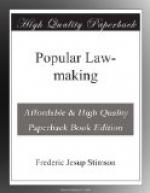But in these early days all matters concerning marriage,
divorce, guardianship of children, ownership of property
after death, belonged to church law. It is hard
to see why, except that the mediaeval church arrogated
to itself anything that concerned
sin in any
way—anything that concerned the relation
of the sexes, that concerned the Holy Sacraments,
and marriage is a sacrament. Consequently the
mediaeval church claimed that it had jurisdiction
over all marriage, and over all divorce; and also
took jurisdiction over a man’s children at his
death, and over his property, now exercised by our
courts of probate. This they got out of the notion
that when a man was dead, there was something, in
a sense, that went beyond this life in looking after
his property and children. And down until twenty
or thirty years ago all jurisdiction in England in
matters which concerned a man’s property, after
death, belonged to the church courts and their successors.
The church law was based on the Roman law, but was
called
canon law, the technical word, because
it is the “canons” of the church.
It is a convenient term to distinguish it from the
ordinary civil law of the Continent. So that
the Constitutions of Clarendon began what was completed
only under Henry VIII; they very clearly asserted the
claim of the king to be supreme over the Church of
England. The Bishop of Rome, as Henry VIII called
the pope, had no more power than any other foreign
bishop.[2] There still remained the institution known
as benefit of clergy, by which any priest, or later
any clerk or cleric (which word came to mean any one
who could read and write) could get off of any criminal
accusation, at first even murder, by simply pleading
his clergy; in which case the worst that could happen
to him was that he was branded in the right hand.
But the Constitutions of Clarendon were a great step
toward civil liberty. Taken by us in 1164, it
was followed in so neighboring a country as France
only so late as a few years ago. The priests,
however, still managed to retain their jurisdiction
over offences among themselves, as well as over marriage,
the relation between the sexes, slander, usury, and
wills—of matters relating to the sacraments,
and of sins.
[Footnote 1: Stubbs, p. 136.]
[Footnote 2: Yet “Peter’s Pence”
were initiated by Ini, King of the West Saxons, about
690!]
Now this is a very interesting matter, and were it
borne in mind by our modern legislators they would
escape a good deal of unintelligent legislation; that
is, the distinction between a sin and a crime.
A sin is against the church, or against one’s
conscience; matter, therefore, for the priest, or
one’s spiritual adviser. A crime is an offence
against other men; that is, against the state, in which
all are concerned. Under the intelligent legislation
of the twelfth century all matters which were sins,
which concerned the conscience, were left to the church
to prevent or punish. For the same reason usury




